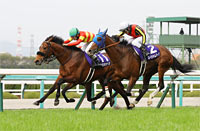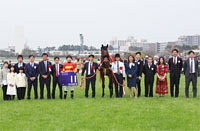Osaka Hai (G1) - Data Analysis
Top middle-distance contest of the spring season
The Osaka Hai, previously a G2 race known to attract top talent, was upgraded to G1 status in 2017. In that year, the race was dominated by 2016 JRA Horse of the Year Kitasan Black. In 2018, Suave Richard secured his first G1 victory in the race following a string of G1 defeats. In 2019, Satsuki Sho (Japanese 2000 Guineas) winner Al Ain notched the win. In 2020, filly Lucky Lilac, a two-time G1 winner, secured the victory. In the years since the race was upgraded to G1 status, all winners have been runners with a solid track record. Let’s now look at some trends in this race based on data for the last four years, during which the race was held as a G1 race.
Top 2 finishers had all contested one of four lead-up races
All Top 2 finishers had previously contested one of the four lead-up races in the table below. Runners coming straight from the Arima Kinen (The Grand Prix) with an intervening rest period, or from a G2 race held in February or March seem to have the highest likelihood of success. Incidentally, if we expand our analysis group to include the last 10 years (including the years during which the race was held as a G2 race), we find that runners coming from the Arima Kinen, Kinko Sho, Nakayama Kinen, and Kyoto Kinen achieved the highest success ratios (Top 3 ratios of 46.7%, 23.5%, 25.0%, and 31.3%, respectively). In addition, runners that had contested a G3 race in their previous race over the last 10 years only had a Top 3 ratio of 4.2%. It would be a good idea to lower our expectations of runners that fall into this category. [Table 1]
[Table 1] Performance by previous race (last four years)
| Previous race |
Performance
[1st-2nd-3rd-4th or lower] |
Win ratio |
Top 2 ratio |
Top 3 ratio |
| Kinko Sho |
2-1-1-12 |
12.5% |
18.8% |
25.0% |
| Nakayama Kinen |
1-1-1-5 |
12.5% |
25.0% |
37.5% |
| Arima Kinen |
1-1-0-2 |
25.0% |
50.0% |
50.0% |
| Kyoto Kinen |
0-1-1-7 |
0% |
11.1% |
22.2% |
| Other race |
0-0-1-18 |
0% |
0% |
5.3% |
Watch finish and time difference with winner in previous race
Looking at performances in terms of finish and time difference with the winner in the previous race, we find that runners that had finished 1st in their previous race achieved a high Top 3 ratio of 33.3%, and note that we should not discount runners that had been defeated with a time difference of 0.6s or less with the winner. Conversely, among runners that had been defeated with a time difference of 0.7s or more with the winner, only one delivered a rebound performance in the Osaka Hai: 2019 winner Al Ain (fifth place in the Kinko Sho with 0.9s time difference with the winner). In other words, we should lower our expectations of runners that have finished far behind the winner in their previous race. [Table 2]
[Table 2] Performance by finish and time difference with winner in previous race (last four years)
Finish and time difference
with winner in previous race |
Performance
[1st-2nd-3rd-4th or lower] |
Win ratio |
Top 2 ratio |
Top 3 ratio |
| 1st |
1-1-3-10 |
6.7% |
13.3% |
33.3% |
| 2nd or lower with time difference with winner of 0.6s or less |
2-3-1-23 |
6.9% |
17.2% |
20.7% |
| 2nd or lower with time difference with winner of 0.7s or more |
1-0-0-11 |
8.3% |
8.3% |
8.3% |
Runners that were highly favored in previous race performed well
Looking at performances by runners in terms of favoritism in their previous race, we observe that the 12 Top 3 finishers over the last four years were all backed as 3rd favorite or higher in their previous race, as shown in the table below. When comparing results in the previous race, we should focus on favoritism rather than finish. [Table 3]
[Table 3] Performance by favoritism in previous race (last four years)
| Favoritism in previous race |
Performance
[1st-2nd-3rd-4th or lower] |
Win ratio |
Top 2 ratio |
Top 3 ratio |
| 1st-3rd favorite |
4-4-4-26 |
10.5% |
21.1% |
31.6% |
| 4th favorite or lower |
0-0-0-16 |
0% |
0% |
0% |
Note: Excluding runners that contested their previous race overseas.
Runner that lead the pack have the edge
Since the Osaka Hai was upgraded to G1 status, all winners were positioned 5th or higher at the 4th corner in the race. While it is difficult to predict how the race will unfold, including the position of the runners, we can use the position at the 4th corner in the previous race as a reference point. Runners that had been positioned 5th or higher when passing the 4th corner in their previous race achieved a Top 3 ratio of 30.0%, while those that had been positioned 6th or lower had a Top 3 ratio of only 12.5%. In other words, we need to focus on runners that are likely to lead the pack. [Table 4]
[Table 4] Performance by position when passing 4th corner in previous race (last four years)
| Position when passing 4th corner in previous race |
Performance
[1st-2nd-3rd-4th or lower] |
Win ratio |
Top 2 ratio |
Top 3 ratio |
| 5th or higher |
4-2-3-21 |
13.3% |
20.0% |
30.0% |
| 6th or lower |
0-2-1-21 |
0% |
8.3% |
12.5% |
Note: Excluding runners that contested their previous race overseas.
Seek out the winner!
Experience of Top 2 finish in a G1 race is a prerequisite
Runners with a strong record in G1 races have always performed well in the Osaka Hai, including during the years it was held as a G2 race. However, since the race was upgraded to G1, the performance of such runners has been even more notable. The last four winners all had experience of finishing in the Top 2 of a G1 race. As this middle-distance G1 race attracts top talent, runners without a solid record in G1 races are likely to fare poorly. [Table 5]
[Table 5] Performance by experience of finishing in Top 2 of G1 race (last four years)
Experience of finishing in
Top 2 |
Performance
[1st-2nd-3rd-4th or lower] |
Win ratio |
Top 2 ratio |
Top 3 ratio |
| Yes |
4-4-3-15 |
15.4% |
30.8% |
42.3% |
| No |
0-0-1-29 |
0% |
0% |
3.3% |
(Yodohito Himezono)
|


















